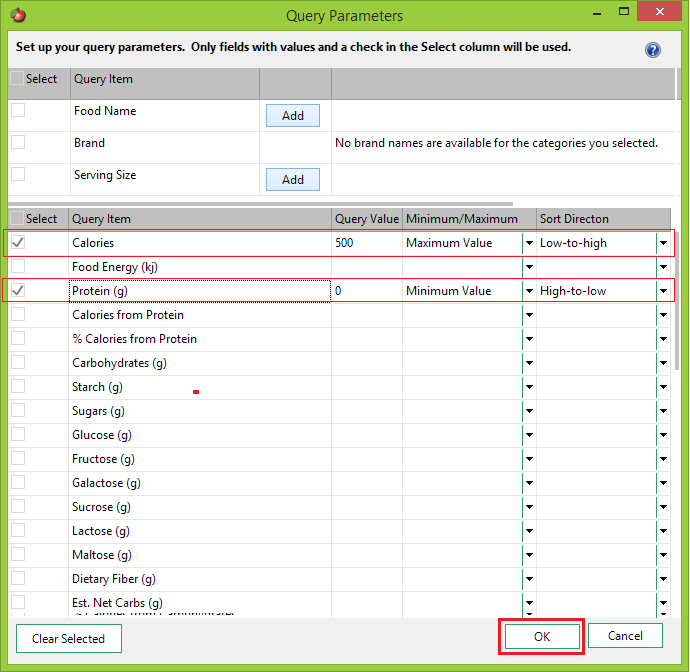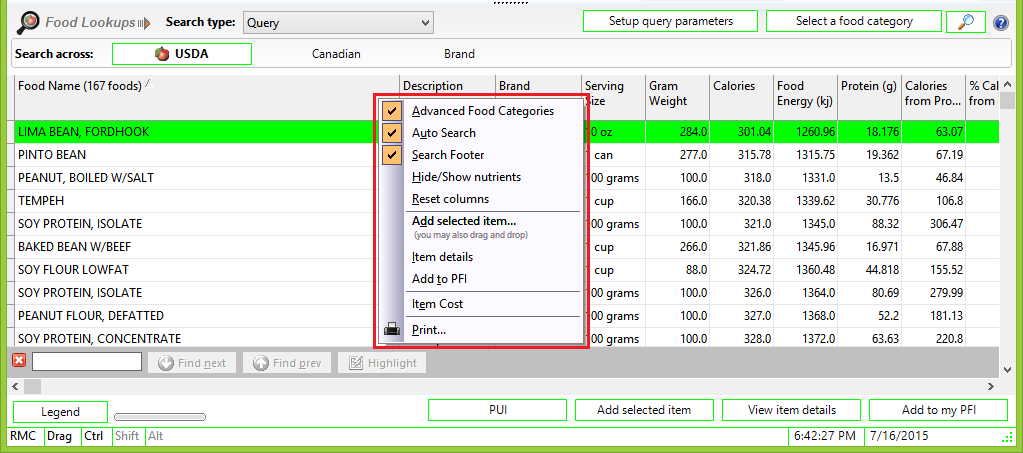| How to Conduct a Query (Boolean AND) Search |
| A NutriBase Query is a Boolean AND search. The NutriBase implementation is very robust. Here is a simple sample query:
In the Search type section, choose the “Query” option. Click the “Select a food category” button. Select a Food Category across which you will conduct your Query. For this example, please select "Fruits" as your food category. You can dismiss this window by closing it. Click the USDA button to confine your Query to the USDA Nutrient Database for Standard Reference.
Click the “Setup query parameters” button. The window shown below will appear. Resize this window as desired. Use this window to define your query parameters.
In this case, we are searching for Fruits. We set 500 calories as the maximum number of calories any food can contain and we told NutriBase to sort these foods from lowest calories to highest. We also told NutriBase to display foods with at least zero protein and display them from high to low. You can specify as many or as few parameters as you wish. In general, the fewer parameters you specify, the more hits you will get. Click the “Okay” button when you are finished.
This type of logic applies to all your queries, even if you specify a large number of parameters. Play with the Query search to “mine” your nutrient database. Click any column header to sort all the displayed data from high-to-low based on the values in that column. (This is a very popular feature.) Click the same column header again to reverse the sort order. You can do this for any nutrient. To add one of the displayed Food Items to a Food Log, Recipe, Meal, or Meal Plan (depending on which NutriBase window you happen to be in), highlight it then:
This menu gives you a variety of options: The Auto Search option tells NutriBase to reconduct the previous search when you select another Food Category. The Search Footer option allows you to search for strings within your search results if desired. Hide/Show nutrients allows you to select which nutrients you want to display in your Search Results. Reset columns returns your nutrient columns to their original default positions (after you have rearranged them by dragging and dropping them into a new sequence). Add selected Item adds the selected item to your Food Log, Recipe, Meal, etc. Selecting Item details shows all the data for the selected food item in a single screen view. (You can also do this by simply double-clicking any food item.) Add to PFI will transfer the selected food item and add it to your Personal Foods as a PFI. (You can go back to it later and edit it as desired.) Item cost allows you to add the cost of any highlighted food item. This topic updated 07/16/2015 |

 Note: If you want to specify Food Subcategories as well as a major Food Category, right click over the Search Results area and click the “Advanced food categories “ option. . You may dismiss this window (by closing it) if you want to. Selecting this option allows you to select not only the major Food Category ("Fruits"), but also this major food category's subcategories (All, Dried, Fresh, Packaged).Clicking the ALL option will check all the options (Dried, Fresh, Packaged) for you or un-check them all.
Note: If you want to specify Food Subcategories as well as a major Food Category, right click over the Search Results area and click the “Advanced food categories “ option. . You may dismiss this window (by closing it) if you want to. Selecting this option allows you to select not only the major Food Category ("Fruits"), but also this major food category's subcategories (All, Dried, Fresh, Packaged).Clicking the ALL option will check all the options (Dried, Fresh, Packaged) for you or un-check them all.

 Click the “Search” button to conduct the Query. When this search is finished, notice that the fruits are arranged from lowest calories to highest (up to a maximum of 500 calories). The protein values are listed from high-to-low. When two foods have the same number of calories, the one with the most protein is listed first.
Click the “Search” button to conduct the Query. When this search is finished, notice that the fruits are arranged from lowest calories to highest (up to a maximum of 500 calories). The protein values are listed from high-to-low. When two foods have the same number of calories, the one with the most protein is listed first.
